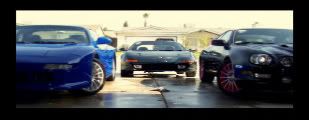 Dec 7, 2009 - 5:46 AM Dec 7, 2009 - 5:46 AM
|
|
|
Enthusiast   Joined Jun 25, '08 From CA Currently Offline Reputation: 0 (0%) |
Ok so in my quest to learn as much as I can about engines, I read an article on the Honda F20C engine found in the S2000 and read how it has Counter Rotating Camshaft's. So I started to look into this and most DOHC engines that drive both the camshafts by the belt have camshafts that spin in the same direction. I also realized that the shafts spinning have momentum and since 2 shafts spinning in the same direction creates double the momentum and vibration which is probably a reason why DOHC engines don't exceed 2.0L without suffering from vibrations unless using balance shafts (Aside from internal Balance issues as well). But then I started thinking about my car and realized that since the intake cam is being driven by the timing belt and the slave cam gear is driving the exhaust camshaft that means that our camshafts are also counter rotating. And assuming logic here two shafts spinning in the opposite direction at the same speed would cancel out any vibrations they might have? Assuming there both the same weight but just from looking at them I can tell the intake camshaft probably weighs a tad bit more than the exhaust since its longer to reach the cam gear. But I do notice our engines are just as smooth running as many smaller engines and I'm curious to know if the fact that our camshafts rotate against each other is another form of balance and vibrational control to keep the engine from running harshly at higher RPM's
|
 |
Replies
 Dec 7, 2009 - 7:22 AM Dec 7, 2009 - 7:22 AM
|
|
|
Enthusiast      Joined Mar 20, '07 From Bakersfield, CA Currently Offline Reputation: 10 (100%) |
You got me man, I have no idea
-------------------- 91 MR2 Turbo SW20, 92 MR2 Turbo SW20, 95 Celica GT ST204
 |
Posts in this topic
 RavenAegis45 An Odd question about the camshafts of a 5S-FE Dec 7, 2009 - 5:46 AM
RavenAegis45 An Odd question about the camshafts of a 5S-FE Dec 7, 2009 - 5:46 AM
 RavenAegis45 yeah its a kind of complex setup to get around you... Dec 8, 2009 - 12:19 AM
RavenAegis45 yeah its a kind of complex setup to get around you... Dec 8, 2009 - 12:19 AM

 Mstoochn QUOTE (RavenAegis45 @ Dec 8, 2009 - 12... Dec 8, 2009 - 3:24 AM
Mstoochn QUOTE (RavenAegis45 @ Dec 8, 2009 - 12... Dec 8, 2009 - 3:24 AM
 Smaay you have an interesting theory about vibration, to... Dec 8, 2009 - 9:53 AM
Smaay you have an interesting theory about vibration, to... Dec 8, 2009 - 9:53 AM

 RavenAegis45 QUOTE (Smaay @ Dec 8, 2009 - 10:53 A... Dec 10, 2009 - 12:37 AM
RavenAegis45 QUOTE (Smaay @ Dec 8, 2009 - 10:53 A... Dec 10, 2009 - 12:37 AM

 Smaay QUOTE (RavenAegis45 @ Dec 9, 2009 - 9... Dec 10, 2009 - 9:30 AM
Smaay QUOTE (RavenAegis45 @ Dec 9, 2009 - 9... Dec 10, 2009 - 9:30 AM
 Hanyo the balance shaft you mention earlier is to help d... Dec 10, 2009 - 3:18 AM
Hanyo the balance shaft you mention earlier is to help d... Dec 10, 2009 - 3:18 AM
 pittfirefighter QUOTE (RavenAegis45 @ Dec 7, 2009 - 6... Dec 10, 2009 - 9:28 AM
pittfirefighter QUOTE (RavenAegis45 @ Dec 7, 2009 - 6... Dec 10, 2009 - 9:28 AM
 pittfirefighter now thats a beauty ^^^
reminds me of a 7th gen ... Dec 10, 2009 - 9:58 AM
pittfirefighter now thats a beauty ^^^
reminds me of a 7th gen ... Dec 10, 2009 - 9:58 AM
 Mstoochn Im confused u say 2zz-gte, but i see a SC, not tur... Dec 10, 2009 - 5:16 PM
Mstoochn Im confused u say 2zz-gte, but i see a SC, not tur... Dec 10, 2009 - 5:16 PM
 Bitter 2zz is smooth until you bounce off rev limiter. Dec 10, 2009 - 8:41 PM
Bitter 2zz is smooth until you bounce off rev limiter. Dec 10, 2009 - 8:41 PM  |
1 User(s) are reading this topic (1 Guests and 0 Anonymous Users)
0 Members:
| Lo-Fi Version | Time is now: July 18th, 2025 - 11:14 AM |



